1LT Alexander “Sandy” Nininger was consigned to the grave of an Unknown Soldier by the celebrity of the Medal of Honor.

In the early, dark days of World War II, America needed something to feel good about and the courage of 1LT Alexander Nininger was just the thing. Sandy came through for America and American bureaucracy returned the favor by consigning his remains to eternity as an Unknown Soldier.
Ironically, Ira Cheaney and Alexander Nininger, best friends at West Point, died many miles and days apart only to be reunited in death by the deception promoted by their former commanding officer, Colonel George S. Clarke.
”READ_MORE”
Citation: For conspicuous gallantry and intrepidity above and beyond the call of duty in action with the enemy near Abucay, Bataan, Philippine Islands, on 12 January 1942. This officer, though assigned to another company not then engaged in combat, voluntarily attached himself to Company K, same regiment, while that unit was being attacked by enemy force superior in firepower. Enemy snipers in trees and foxholes had stopped a counterattack to regain part of position. In hand-to-hand fighting which followed, 2d Lt. Nininger repeatedly forced his way to and into the hostile position. Though exposed to heavy enemy fire, he continued to attack with rifle and hand grenades and succeeded in destroying several enemy groups in foxholes and enemy snipers. Although wounded 3 times, he continued his attacks until he was killed after pushing alone far within the enemy position. When his body was found after recapture of the position, 1 enemy officer and 2 enemy soldiers lay dead around him.
Just as COL Clarke’s self-serving deception prevented the identification and burial of 1LT Ira Cheaney, it also insured that five of 1LT Cheaney’s comrades – Lt’s Nininger, Maynard, Green, Compton and Wilson – would also become Unknowns. With the complication of the award to 1LT Nininger of the Medal of Honor, their cases became hot potatoes that no one wanted to touch even with overwhelming evidence of the identity of their remains.
Sandy Nininger and several of his comrades were recovered just as were most of the Bataan casualties, by Master Sergeant Abie Abraham. Sergeant Abraham was quite a colorful character in his own right. He had fought on the left flank of Cheaney and Nininger’s 57th Infantry at Abucay. He knew many of the officers and men of the Philippine Scout units. After more than three years in a POW camp, he was personally selected by General MacArthur to head up recovery of remains on Bataan. Married to a Filipina, he spoke the language and understood the local population.
After his return to the States several years later, MSG Abraham wrote two books about his experiences in the Philippines. Nininger was prominently mentioned with no indication that there was anything unusual about the recovery of his remains. This was a routine recovery until Washington insisted that they knew more than the people on the ground in the Philippines.
The first page of the X-1130 file shows that Abie interviewed the local gravedigger who stated that he had buried five Americans in the Abucay Cemetery in January 1942.

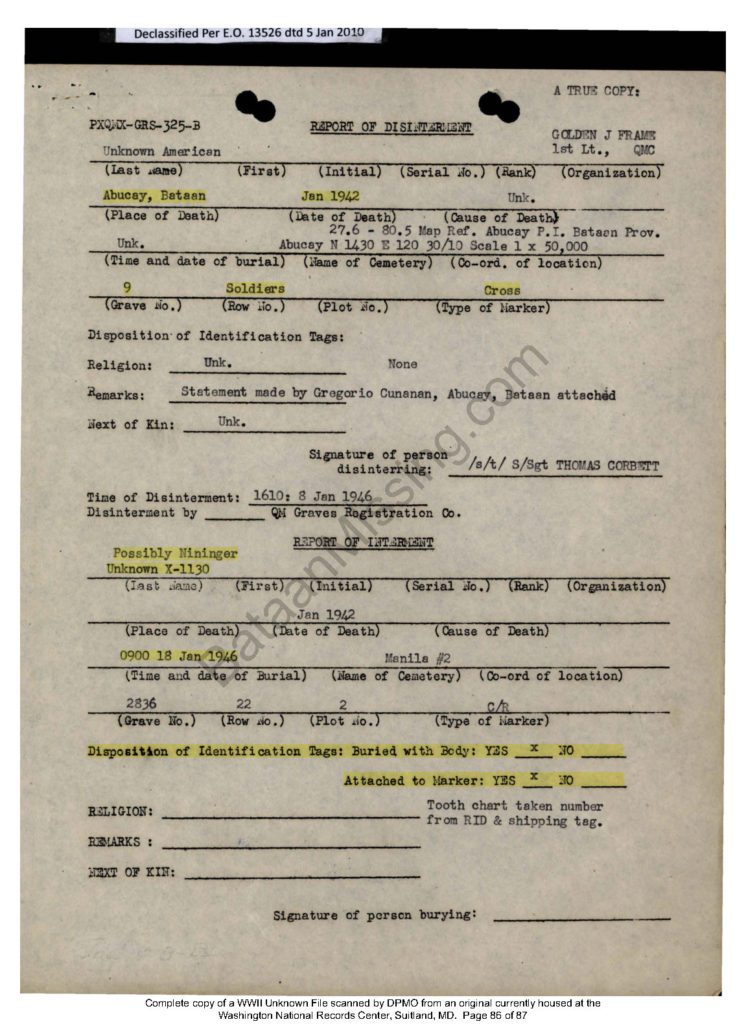
Based on this information, on 8 January, 1946, the remains were disinterred and transferred to the Manila #2 cemetery where they were assigned the number X-1130 with the notation that they were “Possibly Nininger.”
There is no existing record that tells us what information MSG Abraham relied upon in determining that grave #9 was Nininger’s, but nearby graves in the same row were identified either by the name on the grave or by reference to records.
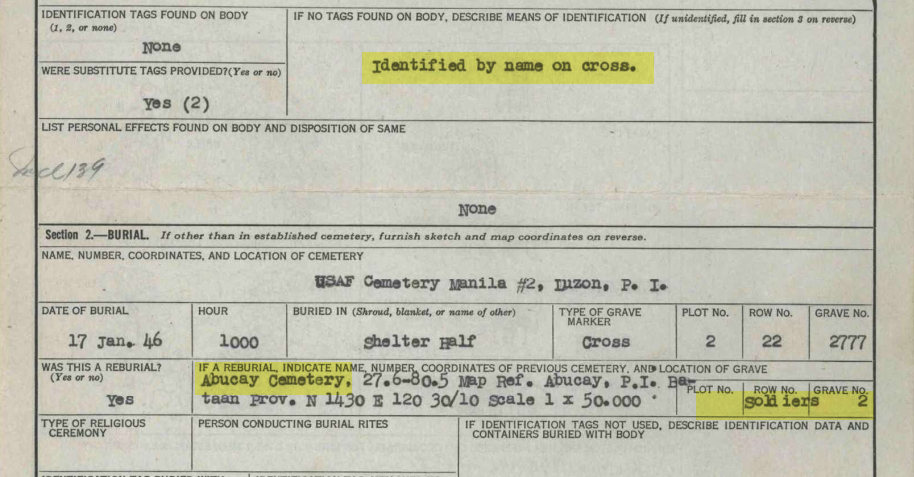

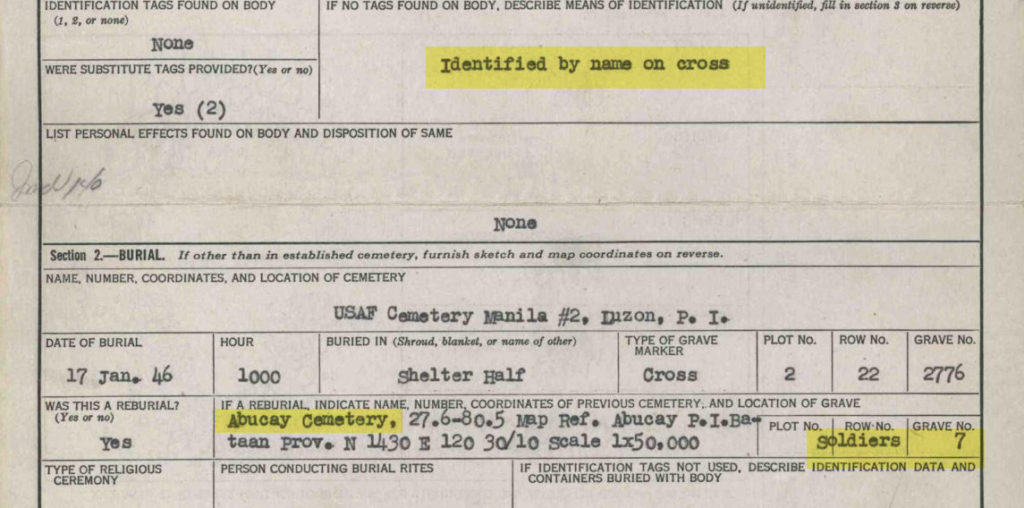
As the investigation progressed and additional information was obtained, a report of interment was prepared and updated with different typewriters and pens as information became available.
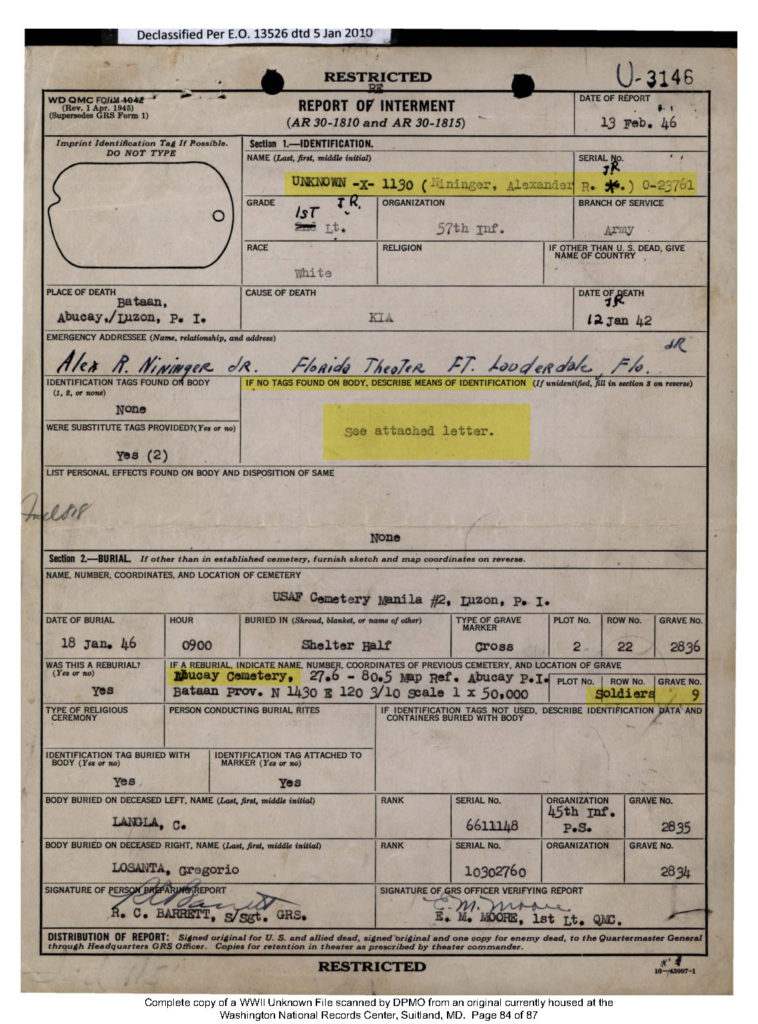
According to the Report of Interment, the means of identification was described in an attached letter that the Army somehow lost and is no longer with the Report of Interment.
By 13 February, 1946, the investigation was complete and X-1130 had been preliminarily identified as the remains of 1LT Alexander Nininger. The identification was then presented to a board of officers in a quasi-judicial proceeding convened by the local command where all the evidence described in the “attached letter” and and all the witnesses pertaining to the identification were available.

The board unanimously recommended that remains X-1130 be identified as 1LT Alexander Nininger. On 27 December, 1948, the local commander transmitted to the Memorial Division in Washington, DC the findings of the board of officers with his recommendation that X-1130 be identified as the remains of 1LT Nininger.
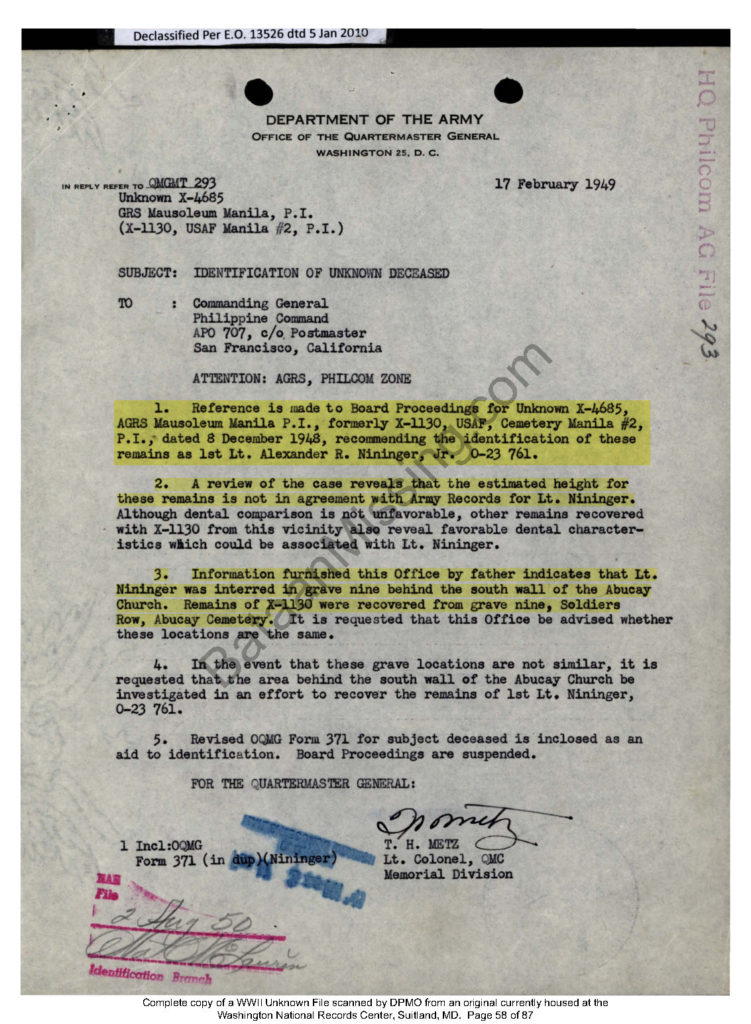
The Memorial Division rejected the board’s recommendation for two reasons:
1. The estimated height for these remains did not agree with Lt Nininger’s known height.
2. Information received, through the family, from Colonel Clarke, that indicated that 1LT Nininger had been buried in Grave #9 of the Abucay Churchyard and the X-1130 remains had been recovered from Grave #9 of the nearby Abucay town cemetery.
The first reason given for disapproval of the recommendation to identify X-1130 as Nininger was that while the dental comparison was not unfavorable, the estimated height of the remains didn’t match his known height. However, these estimates were later proven to be badly in error of the actual height.
In the early 1950’s, Professor Mildred Trotter, an anthropologist at the Department of Anatomy, Washington University, published a series of academic papers based on her work at the Schofield Barracks Mortuary identifying the remains of World War II American casualties.
Professor Trotter found that the formulas and tables previously used in the identification of American servicemen had been based on observations of a 19th Century French population and they substantially understated the actual, ante mortem, height of the modern American servicemen.
COL Clarke had specified that Nininger was buried in “Soldiers Row Grave 9” of the Abucay Church and X-1130 was found in “Soldiers Row Grave 9” of the Abucay (town) cemetery. Perhaps that was just a coincidence or perhaps someone confused the locations which were only a few hundred yards apart – both were cemeteries and both were in the town of Abucay.
The Memorial Division noted the similarity of the grave locations and asked if the Abucay Churchyard and Abucay Cemetery were one and the same location and directed further investigation.
Colonel Clarke had struck again. First the remains of Cheaney, now Nininger was missing because Clarke had provided incorrect information on the burial that occurred when he wasn’t even present on Bataan when they died.
Note that the X-1130 remains had been re-designated as X-4685 when they were removed from Manila Cemetery #2 to the Manila Mausoleum.
The local Graves Registration command, in an unprecedented move, re-investigated the case as directed by Washington; convened a new board of officers; and, again presented to Washington the recommendation that the X-1130 remains be identified as those of 1LT Nininger.
This time they added an explanation of why they didn’t believe that 1LT Nininger had been buried in the Abucay Churchyard. They first noted that the churchyard location was provided by the father of one of the other officers who stated that Lt’s Nininger, Maynard, Wilson, Compton, Green and Captain Meyer had all been buried in the churchyard. They then noted that the records for 1LT Nininger had been compared with all remains recovered from the churchyard with negative results. Further, the remains of Lt Maynard, Lt Wilson and Capt Meyer had all been recovered from other locations and positively identified. The obvious conclusion was that the churchyard burial location was clearly erroneous.
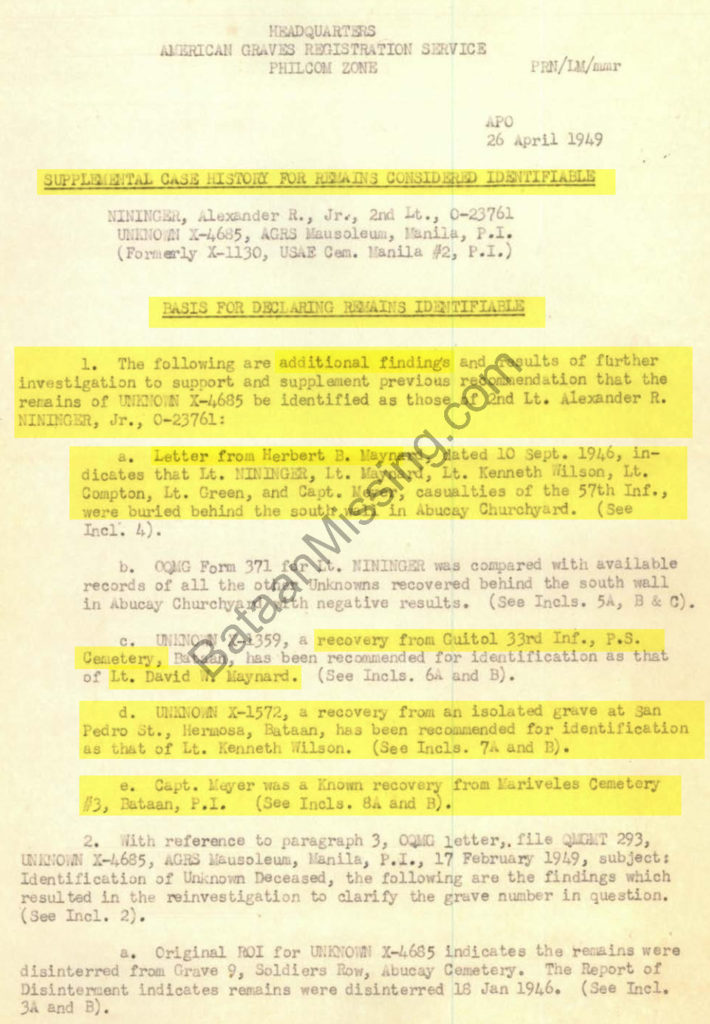
The board’s report then explained that the remains recovered from Grave #9 at the Churchyard had been identified as those of a Philippine Scout, PFC Tranquilino Bales, 6738585, by means of an identification tag. Further, 1LT Nininger’s dental records didn’t compare favorably with these remains.
The report stated that the X-4685 (previously X-1130) remains [recovered from Grave #9 at the Abucay Cemetery] were those of Lt Nininger and unequivocally recommended their formal identification as such.
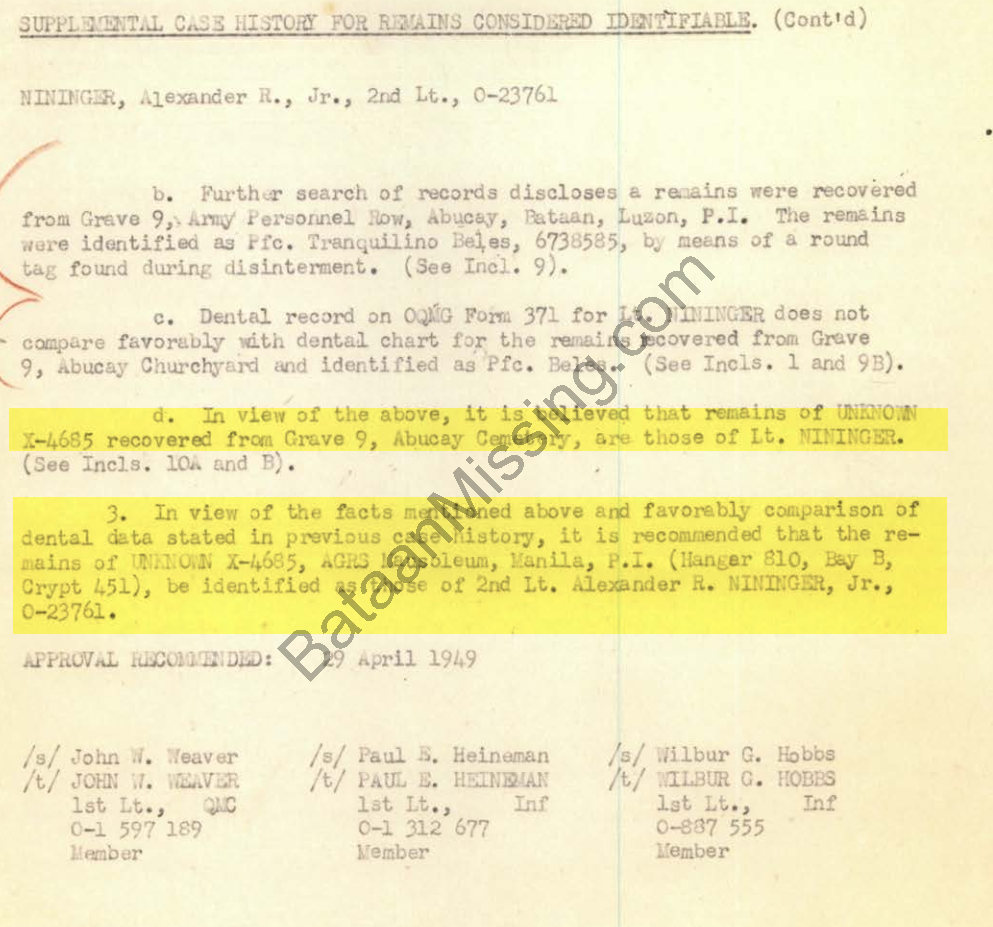
Undeterred by the recommendation of the second board to consider the case, the Memorial Division again disapproved their recommendation based on additional information they had received from LTC Raulston indicating that Nininger had been buried in the Abucay Churchyard and the X-1130 remains were recovered from the Abucay Cemetery. The local command was instructed to re-investigate the facts of the investigation for the third time – and submit a report.
It was later found that LTC Raulston never claimed to have been present at the burial of Nininger or others, but simply stated that burials had been made in the churchyard.
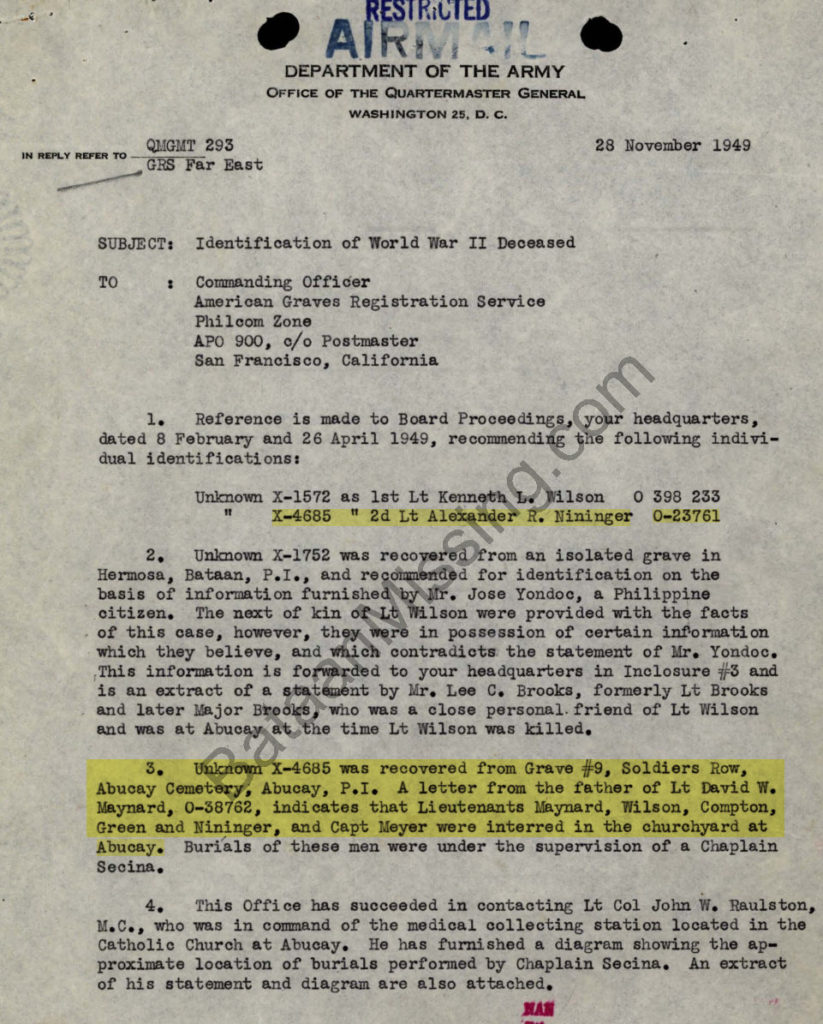
After the third investigation, on 7 March, 1950, the local Graves Registration command in the Philippines submitted a point by point discussion of the issues raised by the Memorial Division with regards to Lt Nininger.

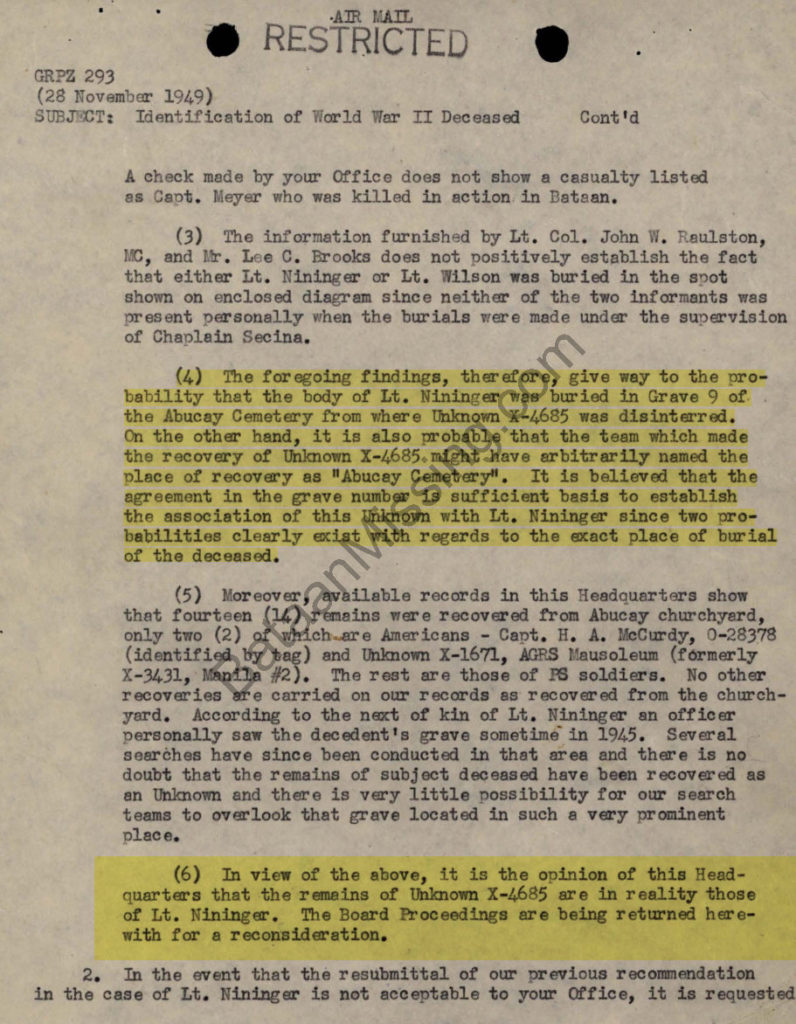
Note the unconditional statement that X-4685 (previously X-1130) is actually 1
LT Alexander Nininger.
The resubmitted recommendation noted the probability that the body of Lt. Nininger was buried in Grave 9 of the Abucay Cemetery from where Unknown X-4685 (previously designated as X-1130) was disinterred. On the other hand, it is also probable that the team which made the recovery of Unknown X-4685 might have arbitrarily named the place of recovery as “Abucay Cemetery” since it was a cemetery and it was in the town of Abucay. It is believed that the agreement in the grave number is sufficient basis to establish the association of this Unknown with Lt. Nininger since two probabilities clearly exist with regards to the exact place of burial of the deceased.
The Philippine command didn’t equivocate when they stated, “In view of the above, it is the opinion of this Headquarters that the remains of Unknown X-4685 are in reality those of Lt. Nininger. The Board Proceedings are being returned herewith for a reconsideration [by the Memorial Division].”
Washington was not to be deterred until they got what they wanted. They wanted off the hook for botching the identifications of these five fine young officers. They knew that Niningers’ Medal of Honor would draw intense scrutiny of everything they had done and that kind of attention is never good in the Army.
The Memorial Division quickly directed the Graves Registration command to conduct another re-investigation and reconsider what was their third recommendation to identify X-1130/X-4685 as Nininger.

The Graves Registration command in the Philippines was determined to put this case to rest and they pulled out all the stops to thoroughly excavate the Abucay Churchyard. They sent a detail of twenty-five laborers, one embalmer and their supervisor to Abucay.
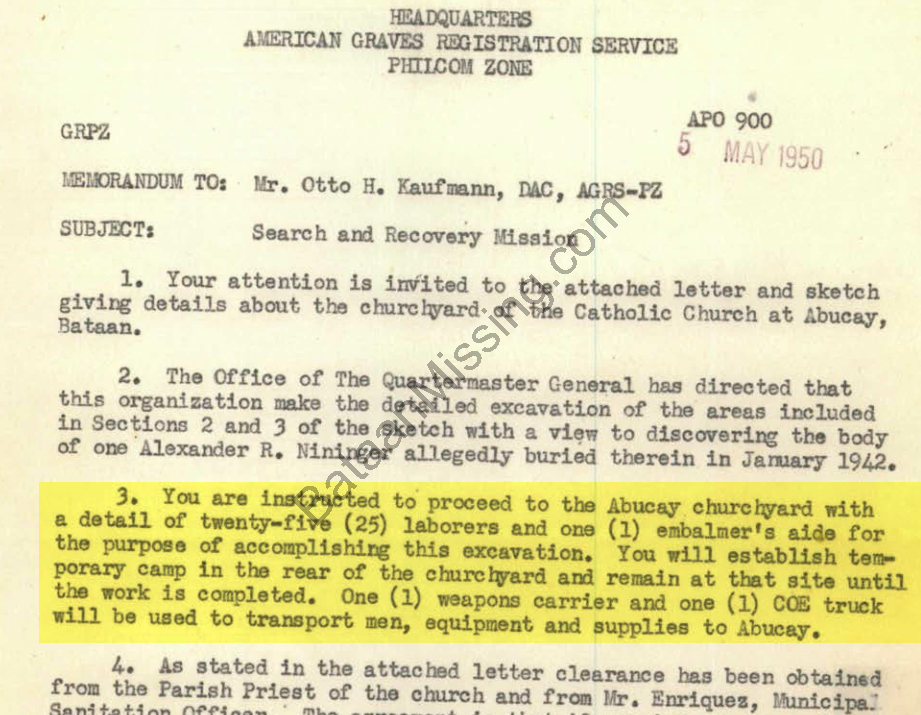
The search detail dug trenches two feet wide and four feet deep every three and one-half feet in the churchyard. They recovered the partial remains of eighteen persons and returned them to the Central Identification Laboratory for processing.
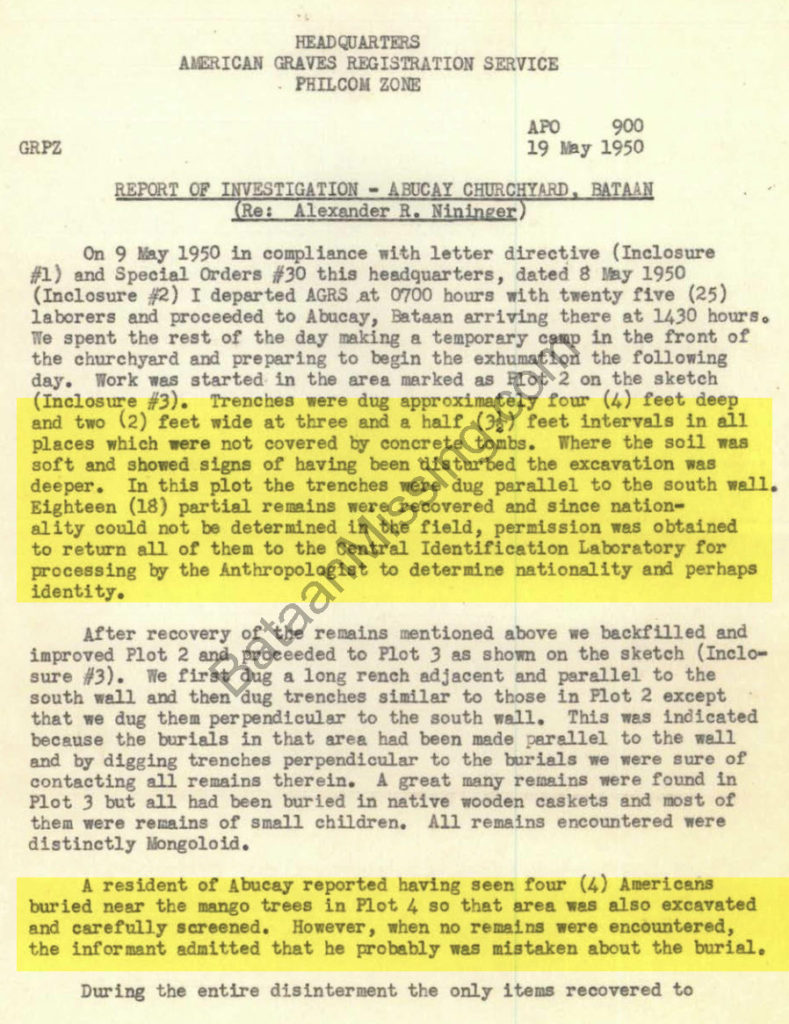
The eighteen remains were examined by an anthropologist and all were determined to be of Philippine ancestry.
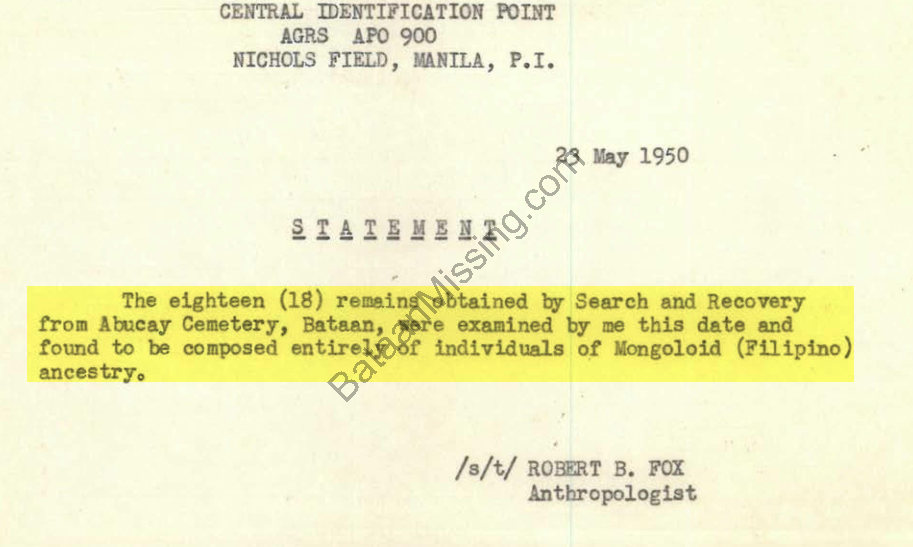
Despite the recommendations of two boards of officers and an extensive excavation of the churchyard, on 12 September 1950, the Memorial Division got what they had demanded, the remains of 1LT Alexander Nininger were officially declared non-recoverable. The Graves Registration command had the last word, though, insisting that the X-1130/X-4685 remains were those of Nininger, but their recommendation had been rejected and they reiterated that LTC Raulson had not been present at the burials.
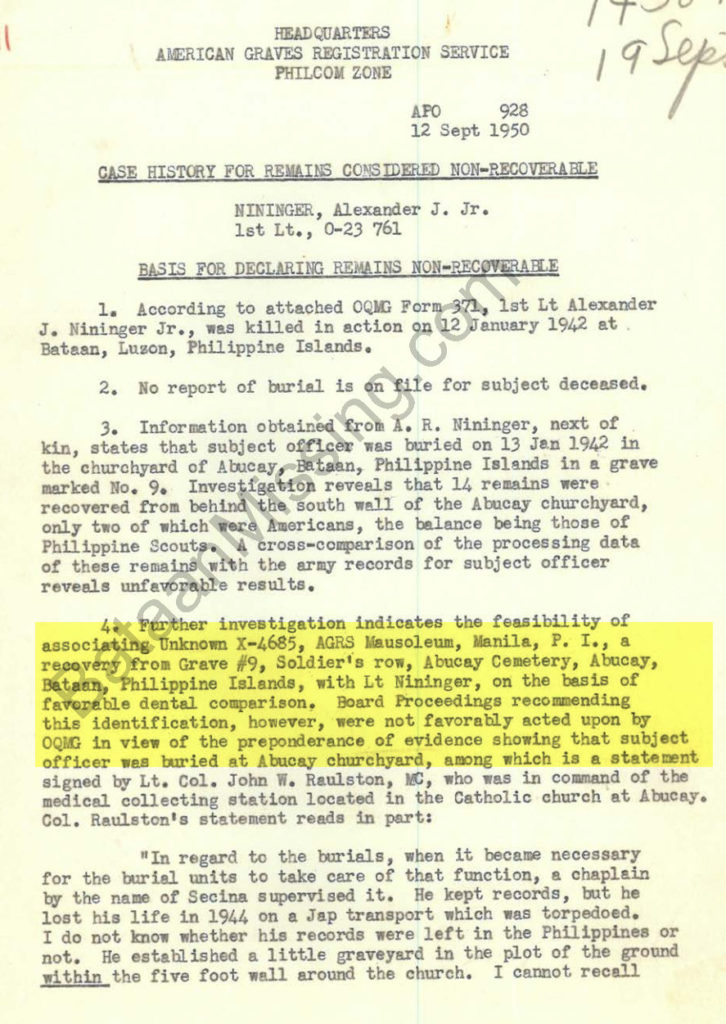
Just seventeen days later, the remains were quickly laid to rest in grave J-7-20 of the Manila American Cemetery. Under means of identification, they added “Nininger, A.R. Jr. O-23761.”
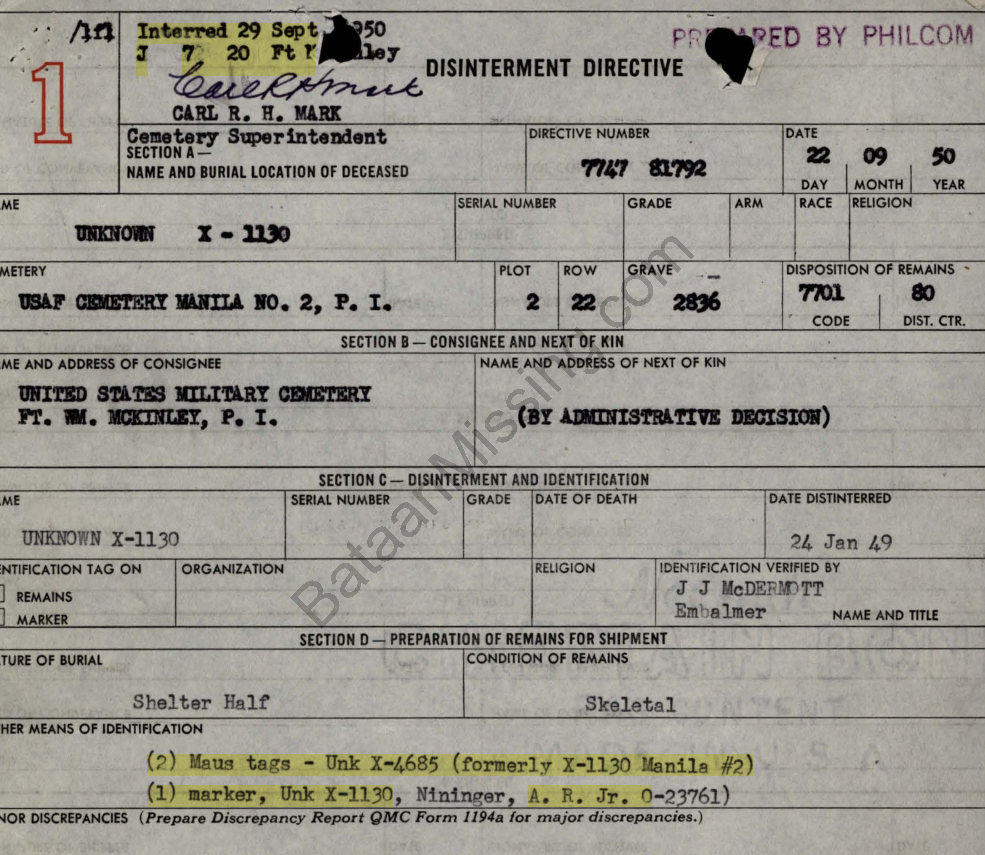

A few weeks after Sandy’s burial, in October 1950, Captain Vogl of the Memorial Division began his investigation that revealed that Colonel Clarke had provided incorrect information on the burials of Ira Cheaney, Alexander Nininger and several others. Without Colonel Clarke’s erroneous information, the X-1130/X-4685 remains likely would have been quickly identified as those of 1LT Alexander R. Nininger as recommended by the review board.
Was Clarke trying to comfort the families? Was he trying to rehabilitate his reputation by implying that he was present when he wasn’t? Or, did he simply make a few honest mistakes, perhaps confusing Cheaney and Nininger and saying Cheaney was buried in Abucay and Nininger was buried in grave 9 of the churchyard when he was actually buried in grave 9 of the nearby cemetery?
For whatever reason Clarke had provided incorrect burial information, the Army had an even bigger problem. At this point, the Army knew they had made mistakes – BIG mistakes. Even in the face of overwhelming evidence that it was incorrect, Washington had chosen to cling to information provided by a disgraced colonel.
Clarke’s incorrect burial information had caused someone to wrongly be buried as 1LT Cheaney at West Point and Lt’s Compton, Green, Maynard, Wilson and 1LT Nininger, a national hero awarded the first Medal of Honor of World War II, to all be buried as Unknowns.
”READ_LESS”
